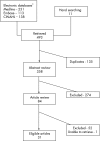Medication errors in paediatric care: a systematic review of epidemiology and an evaluation of evidence supporting reduction strategy recommendations
- PMID: 17403758
- PMCID: PMC2653149
- DOI: 10.1136/qshc.2006.019950
Medication errors in paediatric care: a systematic review of epidemiology and an evaluation of evidence supporting reduction strategy recommendations
Abstract
Background: Although children are at the greatest risk for medication errors, little is known about the overall epidemiology of these errors, where the gaps are in our knowledge, and to what extent national medication error reduction strategies focus on children.
Objective: To synthesise peer reviewed knowledge on children's medication errors and on recommendations to improve paediatric medication safety by a systematic literature review.
Data sources: PubMed, Embase and Cinahl from 1 January 2000 to 30 April 2005, and 11 national entities that have disseminated recommendations to improve medication safety.
Study selection: Inclusion criteria were peer reviewed original data in English language. Studies that did not separately report paediatric data were excluded.
Data extraction: Two reviewers screened articles for eligibility and for data extraction, and screened all national medication error reduction strategies for relevance to children.
Data synthesis: From 358 articles identified, 31 were included for data extraction. The definition of medication error was non-uniform across the studies. Dispensing and administering errors were the most poorly and non-uniformly evaluated. Overall, the distributional epidemiological estimates of the relative percentages of paediatric error types were: prescribing 3-37%, dispensing 5-58%, administering 72-75%, and documentation 17-21%. 26 unique recommendations for strategies to reduce medication errors were identified; none were based on paediatric evidence.
Conclusions: Medication errors occur across the entire spectrum of prescribing, dispensing, and administering, are common, and have a myriad of non-evidence based potential reduction strategies. Further research in this area needs a firmer standardisation for items such as dose ranges and definitions of medication errors, broader scope beyond inpatient prescribing errors, and prioritisation of implementation of medication error reduction strategies.
References
-
- Institute of Medicine To err is human: building a safer health system. Washington, DC: National Academy Press, 1999
-
- Institute for Safe Medication Practices http://www.ismp.org/pressroom/PR20020606.pdf (accessed 26 February 2007)
-
- Web site http://www.ismp.org/PR/PediatricPharmacyGuidelines.htm (last accessed June 17, 2005)
Publication types
MeSH terms
LinkOut - more resources
Full Text Sources
Medical
Miscellaneous


